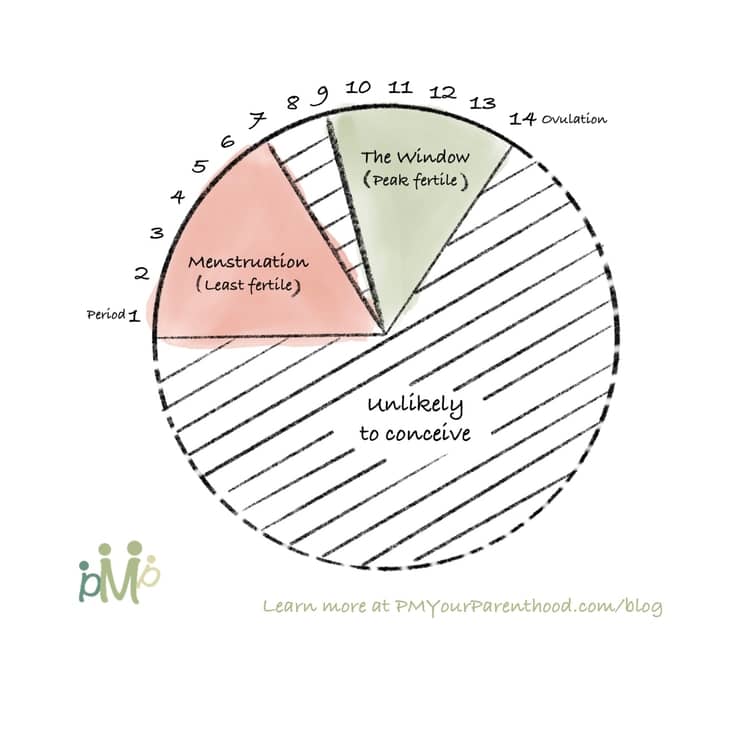Our takeaway:
- Timing for making a baby: for an average 28-day menstrual cycle, the baby-making sex(es) need to happen during Day 9 to Day 14 from the start date of your period. There are other measures available to time the window more specifically to your situation.
- Scientifically, there’s no evidence supports relationship between the timing of sex in relation to ovulation and the gender of the offspring (The Shettles Method). But we might still try it because why not?
Not until I started looking into baby-making seriously, did I realize that how little I’ve learned from the health class back in high school. Even 5 years ago, I was still so afraid to get pregnant after each sex despite of BOTH birth control pill AND condom (LOL all those worries!) Now that I can laugh it off, but I really wish it is that easy to conceive.
It turns out that we actually need to count the days to get the timing right and it is only one of the many factors for a successful conception. I guess it makes more sense now why the world population so far is only 8 billion but not 80 billion.
How to figure out the best timing for baby-making?
So how do we count? Here’s a simple version. For an average 28-day menstrual cycle, Day 14 from the start date of your period is when your body releases eggs (aka “Ovulation”) and sets them to travel down to the uterus. During the next 12-24 hours after release (the average life of eggs), if the eggs meet sperms as they travel, you will have a chance of getting pregnant. Since healthy sperms can typically live up to 5 days, your possible conception window is short: from 5 days before ovulation through the day of ovulation. In other words, the baby-making sex(es) need to happen during Day 9 to Day 14 from the start date of your period. If your menstrual cycle is a bit less or more than 28 days, your window would be a bit ahead or behind.

And of course, this is a general rule assuming everything else function as expected. If they don’t, there are plenty of measures available to time the window more specifically to your situation. For example, track your BBT – Basal Body Temperature, observe cervical mucus, or ovulation pee test kits, etc.
Does the timing matter for girl-making vs boy-making?
Even though my husband and I would be happy either we have girl(s) or boy(s), we sometimes wonder if we can have both, which one first? (and we have different opinions of course!) Can we influence it?
Despite of different technologies out there (i.e: sperm sorting, in virtro fertilization), we are more on the natural side. (Because we don’t care that much about our baby’s sex as long as they are healthy and happy). So here comes the Shettles Method. The theory can be summarized as: Male (Y) sperm are faster but more short-lived than female (X) sperm. So to have a girl, you would want to have sex a couple days prior to ovulation and by the time you ovulate, the boy-making Y sperms would have died. On the contrary, to have a boy, you would want to have sex right on ovulation day so that the boy-making Y sperms would win the race against X sperms and meet the eggs first.
While the theory is easy to understand, there are constant debates on its effectiveness. Proponents claim between 75 and 90 percent effectiveness for the method. Meanwhile, several studies suggested that there was no evidence supporting the Shettles method. A 1995 study in the New England Journal of Medicine suggested that there was no relationship between the timing of sex in relation to ovulation and the gender of the offspring. A May 2021 article in Fertility & Sterility reflected on a paper published in the same journal 50 years earlier that month*, stating that “…scientific journals such as Fertility and Sterility and The New England Journal of Medicine have continued to publish research dispelling the claims of the Shettles Method.”**
Conclusion
With the above, the conclusion would really vary by people. While I believe in science and the rational side of me tells myself to not follow the Shettles method, the emotional side of me is like “Why not? It doesn’t hurt to try?”. So we will see how it goes 😉
Like this article? Share it with your loved ones! Sharing is caring <3
Also check out more blogs here. To get bite-size parenthood wisdom like this, or save infographics for future references, follow us on Instagram (@PMYourParenthood)!
You can support me and my work by contributing a cup of coffee here 🙏:
* Diasio, Robert B.; Glass, Robert H. (May 1971). “Effects of pH on the Migration of X and Y Sperm”. Fertility and Sterility. 22 (5): 303–305. doi:10.1016/S0015-0282(16)38224-3. PMID 4102480.
**Carpinello, Olivia; DeCherney, Alan (May 2021). “Trust science?”. Fertility and Sterility. 115 (5): 1196. doi:10.1016/j.fertnstert.2021.03.001. PMID 33823996. S2CID 233174346.


